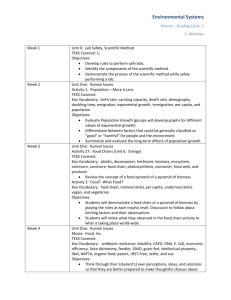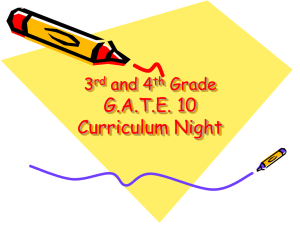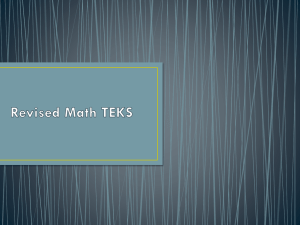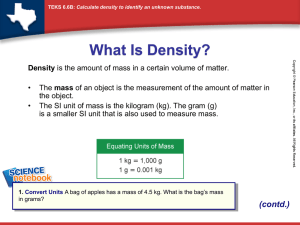Unit 1/Lesson 1: Science Safety & Notebooks
advertisement
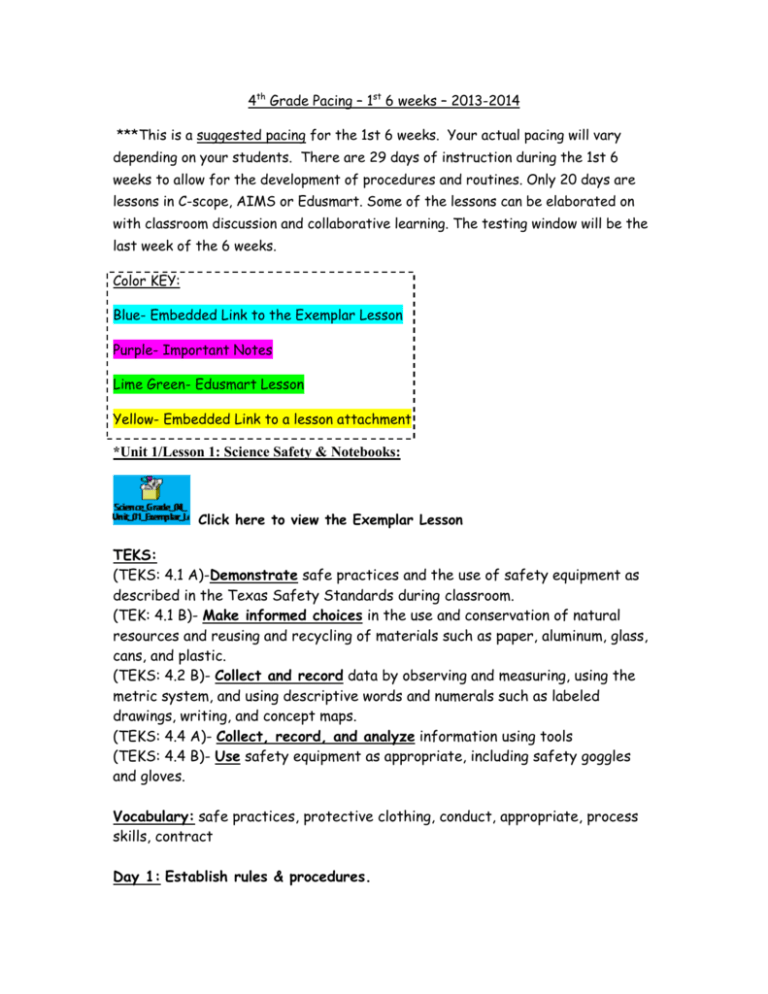
4th Grade Pacing – 1st 6 weeks – 2013-2014 ***This is a suggested pacing for the 1st 6 weeks. Your actual pacing will vary depending on your students. There are 29 days of instruction during the 1st 6 weeks to allow for the development of procedures and routines. Only 20 days are lessons in C-scope, AIMS or Edusmart. Some of the lessons can be elaborated on with classroom discussion and collaborative learning. The testing window will be the last week of the 6 weeks. Color KEY: Blue- Embedded Link to the Exemplar Lesson Purple- Important Notes Lime Green- Edusmart Lesson Yellow- Embedded Link to a lesson attachment *Unit 1/Lesson 1: Science Safety & Notebooks: Click here to view the Exemplar Lesson TEKS: (TEKS: 4.1 A)-Demonstrate safe practices and the use of safety equipment as described in the Texas Safety Standards during classroom. (TEK: 4.1 B)- Make informed choices in the use and conservation of natural resources and reusing and recycling of materials such as paper, aluminum, glass, cans, and plastic. (TEKS: 4.2 B)- Collect and record data by observing and measuring, using the metric system, and using descriptive words and numerals such as labeled drawings, writing, and concept maps. (TEKS: 4.4 A)- Collect, record, and analyze information using tools (TEKS: 4.4 B)- Use safety equipment as appropriate, including safety goggles and gloves. Vocabulary: safe practices, protective clothing, conduct, appropriate, process skills, contract Day 1: Establish rules & procedures. Safety – (Engage: What I know about Science Safety) Description: Students will brainstorm and create a list of classroom safety rules necessary to conduct experiments and activities. Consider using the Round Robin strategy for students to brainstorm safety ideas. Keep these lists to add to the Science Notebook later. You will need the following materials for the lesson: chart paper (1 sheet per student) – Optional markers (1 set per teacher) paper (plain, 1 sheet per group) safety goggles (1 pair per student) –Optional gloves (plastic or latex, 1 pair per student) – Optional. Click on the blue Exemplar lesson link above for details about the lesson. Day 2: Set Up Science Notebook (Explore/Explain: Creating the Science Notebook) Description: The next two days will be setting up the Science Notebook and learning how to use it. You will need the following materials for setting up the Science Notebook: science notebooks (to be used throughout the year, 1 per student), scissors (1 pair per student), colored pencils (per student), glue (stick or liquid, 1 per group). Click on the blue Exemplar lesson link above for details about the lesson. 12_S040101C_Creati ng the Science Notebook.pptx Day 3: Science Notebook continued Day 4: Science Tool Intro. (Explain/Explore: Handling Tools Safely) (explain tools-) Objective: Students will have a discussion about safety tools and their uses. This lesson is a preview for the lesson on day 5. Click on the blue Exemplar lesson link above for details about the lesson. Day 5: Performance Indicator - Demonstrate knowledge of safe practices, including wearing safety goggles and gloves, washing hands, and using materials appropriately, by explaining, in a student science notebook, the class safety rules for investigations. Click on the blue Exemplar lesson link above for details about the lesson. *Unit 1/Lesson 2: Probing Properties: Click here to view the Exemplar lesson TEKS: (TEKS: 4.1 A)- Demonstrate safe practices and the use of safety equipment as described in the Texas Safety Standards during classroom. (TEKS: 4.2 C)- Construct simple tables and charts to organize, examine, and evaluate data. (TEKS: 4.2F)- Communicate valid, oral, and written results supported by data. (TEKS: 4.5 A)- Measure, compare, and contrast physical properties of matter, including size, mass, volume, states (solid, liquid, gas), temperature, magnetism, and the ability to sink or float. (TEKS: 4.4 A)- Collect, record, and analyze information using tools, including hand lenses, metric rulers, Celsius thermometers, triple beam balances, graduated cylinders, magnets, and notebooks. Vocabulary: beams, calibrate, centimeter, cube, color, gas, graduated cylinder, liquid, mass, matter, observable properties, physical properties, scale, pan, solid, solution, state, texture, triple beam balance, volume Day 6: Intro.To Matter (Engage: Observing Matter) Edusmart – Matter Description: This is an interactive lesson that can be used as variety of ways. There are pauses periodically so you can have a discussion, teachable moment and/or discuss the notes. If you want to have students use the fill in the blank notes, print and copy them off prior to showing the lesson. There are also essay and multiple choice questions that can be used as a grade. Students can work individually or in teams to answer the questions. If they work in pairs, consider the “Think-PairShare” cooperative learning strategy. Day 7: Mass (Explore/Explain: Massing w/Triple Beam Balance) Description: Students will work in groups of 4-5 to explore the parts and use of a triple beam balance. Then, they will use the triple beam balance to predict and measure the mass of objects. Materials for this lesson are: triple beam balance (1 per group), ruler (metric, 2 per group), objects (to observe and measure, see Advance Preparation, 1 per group), re-sealable plastic bag (see Advance Preparation, 1 per group), Parts of a Triple Beam Balance handout (1 per student), and See and Measure handout (1 per student). Day 8: Volume (Explore/Explain: Volume mL) Description: Students will connect their thinking about properties of matter (mass) from yesterday to learn about measuring volume as another property of matter. Students will work in groups of 3-4 to predict and measure volume for cylinders using beans and boxes using cubes to determine which container will hold the greatest volume. Then, the class will create a working definition for the term “volume.” Materials for this lesson are: paper (construction, cut in half, 1 sheet per group), graduated cylinder (1 per group), glue (1 per group), tape (1 per group), scissors (2 pairs per group), beans (about 2 cups, see Advance Preparation, per group), cubes (cm, see advance Preparation, per group), re sealable plastic bags (see Advance Preparation, 2 per group), Volume Busters handout (1 per group), and Volume Boxes handout (1 per group). Day 9: Volume cont. (Explore/Explain: Volume mL) Day 10: Sink & Float (Explore/Explain: Sink and Float) Description: Students will predict and test the buoyancy of a lemon, lime and orange, then determine which objects will float and which will sink. Materials for this lesson are: container with water (clear, 2 quart or larger, for demonstration, 1 per teacher and 1 per group), lemon (about 3 ounces), 1 per class lime (about 3 ounces, 1 per class), orange (about 3 ounces, 1 per class), objects (variety that will sink or float, see Advance Preparation, 1 set per group), re-sealable plastic bags (see Advance Preparation, 1 per group), paper towels (per class), and the Float or Sink handout (1 per group). Day 11: Matter (Elaborate: A Matter of Matter) Description: Students will divide into groups of 3-4 and discuss the properties of a variety of objects and then determine which two have the most properties in common. Materials for this lesson are: objects (variety to observe physical properties per class, safety goggles, 1 pair per student), nail (iron, 1 per teacher), aluminum foil (1 sheet per teacher), and A Matter of Matter handout (1 per student). Day 12: AIMS: Crazy Combo NOTE: There is cornstarch in your campus science closet. Description: Students will divide into groups of 4 and discuss create a substance. Then, determine whether the substance is a liquid or solid based on the properties of matter. Materials for this lesson are: One box of cornstarch per class, 300-315 ml of water per class, 1 gallon Ziploc bag per class, 1 hammer per class, 1 square of aluminum foil per group, 2 clear plastic cups per group, one 30 cm square of wax per group, a wooden clothes pin per group, one votive candle per group and matches for each group. *Unit 1/Lesson 3: The Heat is on: Click here to view the Exemplar lesson TEKS: (TEKS: 4.1 A)- Demonstrate safe practices and the use of safety equipment as described in the Texas Safety Standards during classroom. (TEKS: 4.2 A)- Plan and implement descriptive investigations, including asking well-defined questions, making inferences, and selecting and using appropriate equipment or technology to answer his/her questions. (TEKS: 4.2B)- Collect and record data by observing and measuring, using the metric system, and using descriptive words and numerals such as labeled drawings, writing, and concept maps. (TEKS: 4.2D)- Analyze data and interpret patterns to construct reasonable explanations from data that can be observed and measured. (TEKS: 4.2F)- Communicate valid, oral, and written results supported by data. (TEKS: 4.4 A)- Collect, record, and analyze information using tools, including hand lenses, metric rulers, Celsius thermometers, triple beam balances, graduated cylinders, magnets, and notebooks. (TEKS: 4.5 A)-Measure, compare, and contrast physical properties of matter, including size, mass, volume, states (solid, liquid, gas), temperature, magnetism, and the ability to sink or float. (TEKS: 4.5B)- Predict the changes caused by heating and cooling such as ice becoming liquid water and condensation forming on the outside of a glass of ice water. Vocabulary: heat energy, heat, transfer, condensation, melting, freezing Day 13: Edusmart: Heating & Cooling Description: This is an interactive lesson that can be used as variety of ways. There are pauses periodically so you can have a discussion, teachable moment and/or discuss the notes. If you want to have students use the fill in the blank notes, print and copy them off prior to showing the lesson. There are also essay and multiple choice questions that can be used as a grade. Students can work individually or in teams to answer the questions. If they work in pairs, consider the “Think-PairShare” cooperative learning strategy. Engage: Comparing Hot & Cold Description: Students will divide into groups of 4 to observe changes that occur when food color is added to cold and hot water. Materials for this lesson are: cup (clear, 2 per group), ice water (per group), hot water (per group), thermometer (1 per group), timer (1 per group), food coloring (blue and yellow, 1 container of each color per class,) colored pencils (per group), and Comparing Hot and Cold handout (1 per student). Day 14: Changes caused by heat (Explore – Icy Plans) Description: Students will have a discussion about the prior day’s lesson and then divide into groups of 4 to plan a descriptive investigation on how to change ice to liquid water. Their plan should include a question, materials, a procedure and observation. Materials for this lesson are: Icy Plans handout (1 per student), chart paper (per class), and markers (1 set per teacher). Day 15: Students act out plan changing ice to water from day 14. Be sure to have students write out their process and use and IF…THEN statement for a hypothesis (testable question). Day 16: Changes caused by heat cont. (Explore – Heat Can Cause Change) Description: Students will pair up with another person who has the matching card that shows changes caused by heat. Then, students should write or draw their understanding of the changes in matter caused by heating. Materials for this lesson are: 1 piece of paper per student and a Heat Can Cause Change teaching master. Day 17: Heat powering the Water Cycle (Explain – Water on the Move) NOTE: The focus of this lesson is NOT the water cycle. It is on the heat that powers the water cycle. Students learned about the water cycle in 2nd grade so they should be familiar with it. Description: The teacher will choose a book about the water cycle to read to the class. Kids usually enjoy The Magic School Bus book about the water cycle. Students will then observe the changes in heat that occur during the water cycle during the class demonstration. Materials for this lesson are: book (on the water cycle, 1 per class), cup of ice water (plastic, 6-8 ounce, 1 per class), hot plate (1 per class), small pot (1 per class), mirror (about 4 x 6 inches, 1 per class), Water on the Move handout (1 per student), and Water on the Move key/Transfer of Heat key for the teacher. Day 18: Heat powering the Water Cycle cont. AIMS – Ice Change: The Meltdown Description: Students will predict the time it takes for an ice cube to melt, then conduct an experiment to determine the actual time. Materials for this lesson are: ice cube (1 per group), one six inch plate (1 per group), and 1 student page per student. Day 19: Impact of Heating & Cooling (Elaborate – Changes by heating & and absence of heat in everyday life) 12_S040103F_The Impact of Changes by Heating or Cooling.pptx Description: Show and discuss the power point on changes in heat, then students will reflect on what they have learned in their interactive journals. NOTE: CScope uses the term cooling. Please make sure that students know that cooling is the absence of heat. Scientists discuss either heat or the lack of heat. They generally do not use the term cool. Day 20: Matter wrap-up Matter Jeopardy – AIMS Description: Students will gather data on mystery matter based on the physical properties of the object in each station. Then, the game of Matter Jeopardy will determine if each group got the properties of each mystery matter correct. Materials for this lesson are: assorted solids and liquids, a large box, measuring tools, magnets, clear plastic cups, large tub of water, paper towels, and student pages (one per student). Day 21-29: Elaboration, Collaboration, Review & Assessment NOTE: The assessment will contain two questions that use the terms mixtures and solutions, but it is only related to heating and temperature. Although the 2nd unit is shown to be covered on the 1st six weeks, it will not be addressed and tested until the 2nd six weeks.



